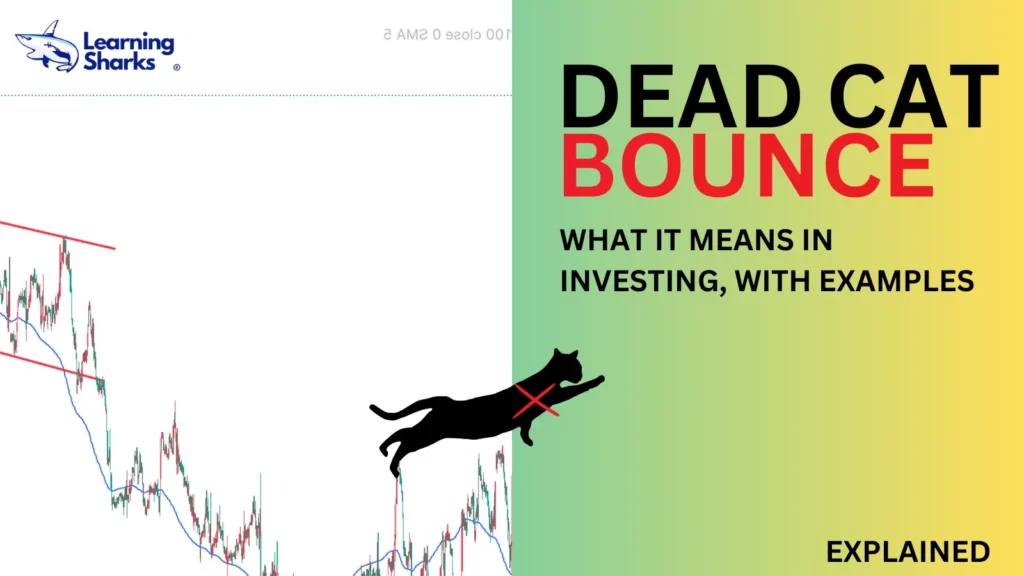
Introduction
In the world of finance and investing, a wide range of market behaviour are described using a variety of terminologies. They include “dead cat bounce.” Despite having a rather strange name, this phenomena has significant ramifications for traders and investors alike. The definition of a dead cat bounce, its causes, and the appropriate responses from market participants will all be covered in this essay.
Understanding the Dead Cat Bounce
A “dead cat bounce” is a figurative term for a brief and transient rise in the price of a sinking asset or investment. By comparison, even a dead cat will momentarily bounce if dropped from a very high place. In the financial markets, a stock or index may experience a brief bounce after a steep decline, giving the impression of a potential recovery.
Causes of a Dead Cat Bounce
Numerous factors could cause a dead cat bounce.
Here are some examples of usual causes:
- Technical adjustments may be necessary after significant declines in markets with high volatility.
- Oversold situations can lead to short-term purchasing pressure and a temporary increase, which technical analysts can spot.
- Investor psychology: When a stock has a sharp decrease, those looking for a good deal are lured to it because they believe the price has come to a beneficial level. This rush of buyers may lead to a brief return even if the root causes of the decline are not changed.
- Short sellers may be forced to buy shares in order to close out their positions in a heavily shorted stock where traders bet on the price falling if there is a swift price turnaround or positive news.
Consequences for Market Participants
Traders and investors need to comprehend the dead cat bounce phenomena and its effects:
- False Hope: A dead cat bounce can deceive investors into believing that a market or stock is about to make a robust recovery. To use caution, however, and to determine the primary reasons for the early decline.
- Trading possibilities: Despite the dead cat bounce’s brief existence, those looking to profit from market unpredictability may find trading possibilities there. For smart traders who can exactly time their entry and exits, the price swings brought on by this phenomenon may be lucrative.
- Risks over the long term: While a dead cat bounce may offer some solace, it is not usually a sign that the long-term trend is shifting. Investors should undertake adequate research and consider the underlying factors that led to the decline before making a decision on an investment.
Conclusion
The market term “dead cat bounce” refers to a momentary rise in the value of a declining asset. Market participants must comprehend this idea in order to prevent falling into traps and making hasty investment decisions based on brief price changes. By conducting thorough research, looking into fundamental concerns, and considering market patterns, investors can more effectively navigate the complexity of financial markets and make intelligent investment selections.
A dead cat may quickly come back to life, but it still serves as a metaphor for the need for careful research and thoughtful consideration when making investments.
Learn more about these phrases by visiting our courses.
The idea of the dead cat bounce is frequently referenced. For more details, consult the following sources:
- Investopedia – “Dead Cat Bounce”: https://www.investopedia.com/terms/d/deadcatbounce.asp This article provides a comprehensive definition of the dead cat bounce phenomenon, along with examples and insights into its causes and implications.
- The Balance – “Understanding the Dead Cat Bounce in Stocks”: https://www.thebalance.com/dead-cat-bounce-definition-and-example-4172336 This resource offers a detailed explanation of the dead cat bounce, including its origins, characteristics, and strategies for trading during such market conditions.
- Seeking Alpha – “The Dead Cat Bounce”: https://seekingalpha.com/article/237438-the-dead-cat-bounce This article explores the dead cat bounce from an investor’s perspective, discussing how it can create trading opportunities and the importance of distinguishing between short-term rallies and long-term trends.
- Financial Times Lexicon – “Dead Cat Bounce”: https://lexicon.ft.com/term?term=dead-cat-bounce The Financial Times Lexicon provides a brief but informative definition of the dead cat bounce phenomenon and its significance in financial markets.
CHECK OUT OUT LATEST STOCK MARKET COURSES: https://learningsharks.in/share-stock-trading-courses-online/
FOLLOW OUR PAGE: https://www.instagram.com/learningsharks/
